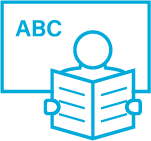Literacy and Child Development in a Contemporary African Society
The author proposes that the literacy practices of a community reflect the cognitive affordances of the script onto particular speech varieties in a sociocultural system. Most research on children’s literacy in Zambia has focused on individual literacy as a set of measurable competencies that can be assessed independently of context, construing language variety or instructional input as extraneous variables. A more integrated focus on literacy as a socially distributed practice in the context of a multilingual African society highlights cooperative learning and flexible communication across language boundaries.
Author: Robert Serpell
Source: Serpell, R. (2020). Literacy and child development in contemporary African society. Child Development Perspectives.
- Children’s opportunities to acquire competence in reading, writing, and understanding texts are distributed unevenly across socioeconomic sectors, posing a challenge to applied research- and evidence-based policy.
- A sociocultural theoretical framework is proposed for understanding the relationship between literacy and child development in the historical context of sub-Saharan Africa and the region’s relations with the rest of the world.
- Literacy is construed as a socially distributed cultural practice within which communication is mediated by the cognitive affordances of particular languages, scripts and technologies.
- Children are introduced to the practice through the participatory appropriation of a system of meanings in institutional settings that reflect the community’s history.
Theoretical and historical framework
- The cognitive work of written communication is socially distributed among participants and scaffolded by technology.
- In learning to read and write, children discover the possibilities for communication afforded by script.
- By allocating graphic symbols to represent elementary speech sounds, an alphabet can map the words of any natural language onto a small set of letters.
- In Zambia, children learn to decode in two ways: Bantu languages, which have a transparent orthography, and English, with much more opaque orthography.
- Societies in which bi- or plurilingualism is prevalent tend to assign different social functions and status to different speech varieties; speakers combine different types flexibly in a single utterance with code-switching or translanguaging.
- Becoming literate expands a child’s communicative competence and provides opportunities for participating in cultural practices.
- Enrolling children in institutionalised basic schooling is designed to prepare them to enter those adult communities of literate practice through the participatory appropriation of a system of meanings that informs the world of literate practices.
- In most African nations, formal schooling was first imposed by Christian missionaries from Western societies as a method for ”civilising” Africans and later consolidated by colonial administrations.
- Zambia’s current public education curriculum is deeply infused with Western cultural hegemony, specifying as principal learning objectives a set of competencies deemed conducive to success in a modern, industrialised economy.
- English is the language of power in Zambian society.
- The various indigenous Bantu languages are preferred for informal everyday discourse and religious worship.
- Nowadays, initial literacy instruction is offered in one of seven indigenous Bantu languages designated by zone.
- English is introduced gradually, first as a subject in grades 2 to 4, then as the principal medium of instruction.
ResultEmpirical research in Zambia
- A study in the 1990s compared learning outcomes of fifth-graders from ciNyanja-speaking families on either side of the border between Zambia and Malawi. The Zambian children had received initial literacy instruction in English, whereas the children in Malawi received the first four years of instruction in ciNyanja. The Malawians scored much higher on a test of reading comprehension in ciNyanja, and no difference was found in a test of English.
- Studies generally support the growing consensus among policymakers that using indigenous languages is an essential adaptation of the Western model of institutionalised public basic schooling (IPBS) for effective mass schooling in Africa.
- The pedagogical rationale for providing initial literacy instruction in a familiar language is to build on a child’s existing communicative competence.
- Older children may play a more critical role than parents in supporting young children’s language and literacy development. Many mothers have less advanced formal education than their children.
- In addition, a more cooperative approach to learning in schools may be adopted. For example, one method uses a classroom seating arrangement in which small groups of learners face one another in learning pods, and the teacher orchestrates within-group interactions.
Policy implications
- If primary school teachers are to serve effectively as “bicultural mediators,” they may need training in the use of a “meta-language” to articulate the interrelated concepts of sound, letter, syllable, and word, drawing learners’ attention to how the rules that govern spelling and decoding differ between the language of power and their familiar indigenous languages.
- In a plurilingual society, instructional practices for early literacy may benefit from adopting a more flexible approach to nurturing plurilingual communicative competence, including hybrid forms, from ensuring pupil involvement in classroom practice, and hence a learner-driven and centred pedagogy.



